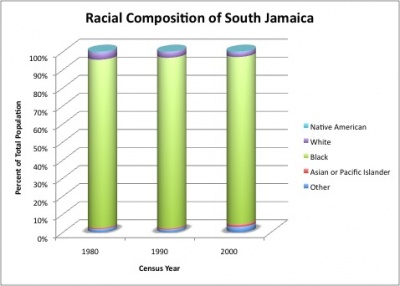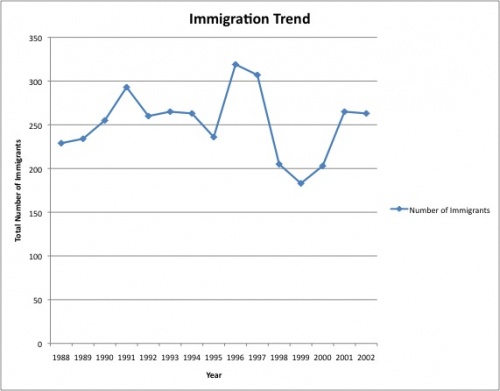Views
Contents |
Immigration & Racial Composition

South Jamaica, throughout its history, has been a predominantly black community. During the early 1800’s, South Jamaica was inhabited by a large number of black families[2]. After the abolition of slavery, blacks from southern communities began to migrate into Jamaica in large numbers[3]. It wasn't until the turn of the twentieth century that South Jamaica's population would truly diversify. At the turn of the century, spurred on by the extension of the trolley to downtown Manhattan and Brooklyn, German, Irish, and Italian immigrants and their descendants began to move into Jamaica.
Between 1922 and 1932, the black population in South Jamaica underwent a rapid growth. It was estimated that there were between twelve and fifteen thousand blacks in Jamaica in 1932[4]. After World War II the black community expanded dramatically, and in the 1950’s and 60’s, the black population in South Jamaica more than doubled from 21,000 to 43,000. In the late 1950s, at least 25,000 whites moved out of the few remaining mixed areas in South Jamaica[5]. By the early 1960’s, South Jamaica’s population was almost entirely African American. In fact, it had the third largest black neighborhood in the New York City.
During the 1980’s, immigrants flocked to South Jamaica with the largest groups coming from Guyana and Jamaica, as well as significant numbers of people from Haiti, Colombia, the Dominican Republic and Trinidad and Tobago[6]. According to the 1980 census, whites made up 4.02% of the population, blacks 93.12%, American Indians 0.42%, Asians and Pacific Islanders 0.70%, Other races of Spanish origin 1.35% and Other races not of Spanish origin 0.39%[7]. In 1990, whites made up 3.27% of the population, blacks 94.39%, Native Americans 0.13%, Asians and Pacific Islanders 0.71%,and Other Races 1.50%. In 2000, whites made up 2.48% of the population, blacks 88.92%, Native Americans 0.36%, Asians 1.33%, Pacific Islanders 0.01%, Other races 2.89%, and Two or more race persons 4.01%. Based on the 1980, 1990, and 2000 census, the total number of whites in South Jamaica dropped from 1226 in 1980 to 936 in 2000. Despite the drop in overall percentage of blacks in South Jamaica, the black population grew between 1980 and 2000 from 28385, in 1980, to 33624, in 2000. The number of Native Americans dropped from 129 in 1980 to 43 in 1990 but by 2000, the number jumped to 138. The Asian population grew slowly during the 1980's, from 212 Asian persons in 1980 to only 231 in 1990. The number of Asian persons in South Jamaica, however, grew significantly during the 90's from 231 in 1990 to 507 in 2000.

Living Conditions & Physical Composition
During the early 1600's Jamaica began to grow as a site of recreational and commercial activity. Beaver Pond, located in present day South Jamaica, provided a principle source of revenue, beaver skins. In the early 1700’s, Beaver Pond was a recreational center for skating and horse racing, with a track having been built around the pond. It was considered the playground of British officers[9]. During the ninteenth century, South Jamaica was primarily a rural area that consisted of an area of scattered farms[10].
At the turn of the twentieth century, the development of South Jamaica at this time was characterized by speculators who preyed upon people who flocked to South Jamaica to escape to an area that was less dense than the slums in Manhattan and Brooklyn. This led to a concentration of poor and shabby constructions that in turn resulted in a continuation of many of the social problems prevalent in the slums from which they fled. In 1909 the Brooklyn Times, March 7th edition, contrasted the rampant crime, poverty, and filth in South Jamaica with the better conditions characteristic to the rest of Jamaica[11].
The bulk of South Jamaica’s housing was built during the post-World War I real estate boom[12]. Many of these homes exist even today. The developers did not use regular street patterns and many blocks were small, irregular, and unpaved. Most of the homes were built on minimum sized lots. Many of the streets lacked public sewers and many homes required cesspools.
By 1936, the housing situation deteriorated to such a degree that then mayor Fiorello La Guardia formed a commission to make a report of the South Jamaica District[13]. The Special Mayor’s Commission found that of 4,040 buildings surveyed, a majority had substantial structural and other deficiencies. Poverty was rampant among blacks, Polish, Italian, and Jewish residents. Inadequate schools, sewers, recreational activities, and street paving plagued the community.
During the 1960’s there was a boom in the construction of large-scale housing developments[14]. Rochdale Village, the second largest housing co-operative in the US, was founded in 1965. Two smaller complexes, Baisley Park Houses and Cedar Manor Homes, were built soon after. Private developers also built approximately 2,500 units of new housing. These new homes were often placed on blocks with old and more deteriorated structures.
South Jamaica, like most inner-city neighborhoods, suffered a rise in crime and decline in income during the 1970s and '80s[15]. It became one of most impoverished and dangerous areas in the city. Throughout the 80’s, South Jamaica was the center of a crack epidemic. Gangs ran rampant, including the Black Spades and Seven Crowns, and drug dealers ruled the streets with an iron fist. The change came on the night of Feb. 26, 1988. That is when rookie police officer Edward Byrne was killed while guarding the home of a drug trial witness. The death of officer Edward Byrne lead then Mayor Mayor Edward Koch to create the Tactical Narcotics Team to sweep the city's worst drug areas, including South Jamaica, with waves of so-called buy-and-bust operations. Life in South Jamaica can be best described by a New York Times article in 1988: "Living in the midst of such violence has made some neighborhood residents prisoners in their own homes. One 51-year-old woman, who has lived here half her life, said she rarely leaves the house these days except to go to work or clean her yard. ''Sometimes, you have to fight your way out the door,'' she said, ''because they're standing there, leaning on your gate.'' On some summer nights, she said, she hears gunfire through the open windows and feels like she's living in ''the Wild West.'' And she added that it was difficult to recruit new members for the South Jamaica Block Watchers Association, one of many neighborhood civic groups, because people were afraid they would be spotted attending meetings and face retaliation"[16].
Living conditions have improved dramatically in South Jamaica since the 1980's. In 1992, an $81 million reconstruction project by the City of New York went under way intended to help improve the infrastructure of southeast Queens, where residents had long been plagued by severe flooding, deteriorating roadways and miles of curbs and sidewalks in major disrepair[17].Today South Jamaica is a predominantly working class neighborhood with a large number of middle class families. The change in living conditions can, to an extent, be captured by the Median Household Income category of the US Census. In 1980, the median household income was $15,814. Near the end of the crack epidemic of the 80s, in the '89 - 1990 Census, the median household income was $33,138. Just before the turn of the twenty first century, the median household income in 1999 was $41,018.

See Also
Return to Main Page
References
- ↑ Infoshare Online. 26 Apr. 2009 <http://infoshare.org>.
- ↑ Gamble, Raymond A. "The South Jamaica Redevelopment Study Plan." Master's thesis, Queen College, 1974
- ↑ Pruden, Gwendolyn Delores. “Urban renewal in South Jamaica” Master's thesis, Queen College, 1976
- ↑ Suggs, Ollie. “The South Jamaica Story.” Master's thesis, Queens College, 1975
- ↑ Eisenstadt, Peter. (2007, July 1). Rochdale Village and the rise and fall of integrated housing in New York City The Free Library. (2007). Retrieved April 16, 2009 from http://www.thefreelibrary.com/Rochdale Village and the rise and fall of integrated housing in New...-a0165359504
- ↑ Lemire, Jonathan. "WORKING-CLASS AREA WORKS AT COMEBACK South Jamaica is 'turning corner.'" New York Daily News, April 27, 2003. http://www.nydailynews.com/archives/ny_local/2003/04/27/2003-04-27_working-class_area_works_at_.html (accessed April 16, 2009).
- ↑ Infoshare Online. 26 Apr. 2009 <http://infoshare.org>.
- ↑ Infoshare Online. 26 Apr. 2009 <http://infoshare.org>.
- ↑ Suggs, Ollie. “The South Jamaica Story.” Master's thesis, Queens College, 1975
- ↑ Lemire, Jonathan. "WORKING-CLASS AREA WORKS AT COMEBACK South Jamaica is 'turning corner.'" New York Daily News, April 27, 2003. http://www.nydailynews.com/archives/ny_local/2003/04/27/2003-04-27_working-class_area_works_at_.html (accessed April 16, 2009).
- ↑ Pruden, Gwendolyn Delores. “Urban renewal in South Jamaica” Master's thesis, Queen College, 1976
- ↑ Suggs, Ollie. “The South Jamaica Story.” Master's thesis, Queens College, 1975
- ↑ Pruden, Gwendolyn Delores. “Urban renewal in South Jamaica” Master's thesis, Queen College, 1976
- ↑ Lemire, Jonathan. "WORKING-CLASS AREA WORKS AT COMEBACK South Jamaica is 'turning corner.'" New York Daily News, April 27, 2003. http://www.nydailynews.com/archives/ny_local/2003/04/27/2003-04-27_working-class_area_works_at_.html (accessed April 16, 2009).
- ↑ Lemire, Jonathan. "WORKING-CLASS AREA WORKS AT COMEBACK South Jamaica is 'turning corner.'" New York Daily News, April 27, 2003. http://www.nydailynews.com/archives/ny_local/2003/04/27/2003-04-27_working-class_area_works_at_.html (accessed April 16, 2009).
- ↑ Gross, Jane. "Weathering the Crack Storm in Queens." The New York Times, March 21, 1988, New York edition. http://www.nytimes.com/1988/03/21/nyregion/weathering-the-crack-storm-in-queens.html?scp=1&sq=Weathering%20the%20Crack%20Storm%20in%20Queens&st=cse (accessed April 26, 2009).
- ↑ Haas, Robin. "SOUTHEAST QUEENS CHEERS FIXUP." New York Daily News, July 10, 2002. http://www.nydailynews.com/archives/ny_local/2002/07/10/2002-07-10_southeast_queens_cheers_fixup.html (accessed April 16, 2009).
- ↑ Infoshare Online. 26 Apr. 2009 <http://infoshare.org>.